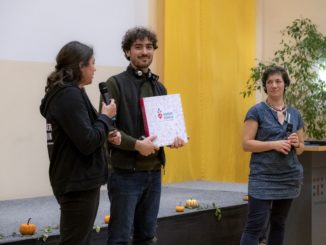
What does digitalisation mean from the perspectives of a diversified, dairy family farm in rural Japan? For more than three generations, the Sudo Family has adapted their farm to the challenges and opportunities of working and living in the southern tip of the Bōsō Peninsula of Japan, Chiba Prefecture. As part of visiting research at the Tokyo University of Agriculture, Prof. Yasuo Ohe and Matteo Metta met Mrs Yoko Sudo, the creative and energetic woman who leads this family farm. They explored how digitalisation is contributing to the Sudos’ diversification efforts, and whether its impact is positive or negative. Here Prof. Yasuo Ohe and Matteo Metta report their observations from Sudo Farm.
By Prof. Yasuo Ohe (Tokyo University of Agriculture) & Matteo Metta
A farm business in the rural and global economy
Sudo, or SudoBoku Co., Ltd is a family farm enterprise in transition to become an agricultural cooperative with its family members. 50 years ago, the family-run farm switched from crops and fruit production (e.g., orange, rice, sugar, potatoes) into dairy farming to follow a new farm vocation and meet the small, but growing trend of milk and dairy consumption in Japan. Today, the farm involves 12 employees, including Yoko, her husband and three children.
Their business consists primarily in dairy farming, and the particular system implemented at Sudo is rare in Japan. Different to the larger farm sizes in Europe, at the time of the visit, Sudo Farm was rearing 110 cows in 6 hectares of grazing area and free stall barn.
There are many conditions which explain the structural challenges of dairy farmers in Japan. Among these, the small-scale farm structure (average Japanese farm size in 2019 was around 2,5 ha), the level of humidity and rain and the shortage of utilised agricultural area in Japan (i.e., around 12% of Japan’s land in 2020) have direct implications on the possibility to pursue organic farming, rotational grazing and forage self-sufficiency.
Yet, the particular soil conditions in this area very suitable to grazing, the policy support to introduce milk at schools since the end of the WWII and the rising domestic demand for local dairy products make this farming system attractive, but still, highly difficult. Japanese dairy farmers must cope with the competitive international market prices, soaring import feed price, stable volume demands and price-setting pressures from big retailers. “Many neighbour dairy farms are running out of business or reducing their dairy herd as result of the unbearable feed prices and the Yen’s monetary deflation”, confesses Yoko with a worried, but positive and constructive spirit.

In this context, diversifying is a matter of survival. Diversification here relies on many strategies: economy of scope and scale, targeting niche markets, redeployment of family labour, professional diversity and creativity of the family farm (e.g., teaching & art backgrounds), and strong partnerships with the actors in the local economy and Tokyo’s metropolis. “While the milk price is fixed and the same for every dairy farmer in Japan, we can however capture higher prices by processing and selling our milk-based products”, explains Yoko. Besides dairy farming, the farm is engaged in on-farm diversification activities like:
- Milk processing: Jersey and Holstein pasteurised non-homogenised milk, raw shakes, soft cream.
- Direct selling: via the on-farm shop, as well as off-farm via their farm online platform, a directly managed store, and procurement agreements with other ice-cream shops, restaurants, hotels, and supermarkets interested in selling Japanese milk and dairy products.
- Educational activities: dairy farming trainings and experiences, farm days for school children.

On-farm digitalisation as part of rural resilience
“Do you rely on digital tools to run your diversification activities and why?”, this was our broader question we asked to Yoko to turn the attention of our English-Japanese translated conversation on digitalisation. Although Yoko warned us: “Sorry, I am not the right person to talk about digitalisation, but my son knows more”, she indeed presented and explained the different digital elements that exist today in the farm:
- Internet connectivity and a free wi-fi zone in the farm courtyard
- The farm website as the main reference point to present the farm, contacts and activities
- Social Media Platforms like Facebook and Instagram to interact with the customers and the community
- The online sale platform to manage orders, payment and milk delivery.
- A farm accountancy software to keep track, store and manage invoices, budget, payments and sales, and perform business analyses.
- An online drive to store and share data, files and information across the different farm activities
Other off-farm digital platforms like TV and mass media channels are also instrumental in promoting the farm story and products to a wider audience. The farm is indeed growing in popularity, receiving important prizes at national level for the entrepreneurial spirit, female entrepreneurship and commitment to the United Nations’ Sustainable Development Goals, which ultimately build a positive story in this rural community and attract new customers and visitors.
“Our farm is the collective result of many workers and interrelated activities. With these digital tools, we can all be on the same picture by sharing information among us. This is essential for our teamwork”, highlights Yoko. Not only is digitalisation instrumental for team, administration, and farm business management, but also to animate the relationships with the community (e.g., through “shake” and soft cream festivals), interact efficiently with customers, and maintain viable businesses in rural areas through direct selling.

Gender and generational division of labour in digital agriculture
“Of course, this increased digitalisation in our farm demands higher data input from all of us and we are not all at ease with this, nor have we always the time to deal with these digital tasks. I can take care of social media messages if needed, but most of the digital tasks are in my children’s hands. For instance, without my son’s wife’s initiative, we could not have an online shop set up today. As she is less involved in the actual farming tasks, but still committed to help the family farm, she took the initiative to launch our online sales right when our on-farm shop was hard hit by the COVID-19 restrictions. Even today when we are recovering from the COVID-19 hardship, she is responsible for the online sale management”, explains Yoko.
Many of the digital tasks required today to run Sudo Farm are in the hands of the younger family generation, i.e., children or their relative partners. While Yoko can autonomously access and interact on digital media, more specialised digital tasks like creating a digital festival poster, set up an online platform and selling process, or manage and update the farm website are in the hands of her son or specialised ICT and graphic experts.
The way forward is beyond digital
Digitalisation cannot alone lead diversification in farms and rural areas, and the Sudo Farm experience shows that its meaningful contribution to rural resilience depends on deeper socio-economic and environmental conditions that no machine can replace or provide. Farm generational renewal in a super-aged country like Japan is a well-known precondition for rural resilience, but other rural specific perspectives must be factored in too if we want to steer digitalisation towards sustainable pathways.
For instance, from our visit to Sudo Farm, we learned the importance of socio-economic needs:
- Supporting the housing, mobility, working and wellbeing infrastructure in farms located in rural areas.
- Creating attractive tax and governance arrangements that stimulate the redeployment of family farm labour, especially women and young people.
- Providing opportunities for lifelong learning schemes, training and competence acquisitions in a wide mix of disciplines and arts that can enhance the connections between agriculture, society and environment.
- Strengthening the equipment and technical infrastructure that are needed by single or grouped diversified farms to adjust production levels, reach economies of scale and diversify the type of products based on the environmental boundaries and market signals.
- Creating market and policy rules that favour shorter food supply chains with high animal welfare standards and a lower environmental footprint.
From the digital point of view, we learnt that:
- Building a digital profile, community and e-commerce platform in a small-scale, diversified family farm enterprise highly depends on the capabilities, motivations and labour availability of the whole family who will run, repair or upgrade these digital tools, even when these are developed with the support of external ICT experts.
- Digitalisation in on-farm diversification requires unique adaptations to the history of the farm and its territorial dimension. Otherwise, digitalisation may result in homogenisation of farms and countryside experience. To express their authenticity, farmers must make creative, strategic and operational efforts.
The ability of this family farm to assemble different pieces of digitalisation and integrate them into festivals, direct sales or educational activities cannot be only a matter of creativity and entrepreneurial spirit. If we work jointly on digitalisation and these structural conditions, maybe on-farm diversification will not become the panacea for many sustainability matters of the modern Japanese food system and rural areas, but at least can make some of these diversification activities easier for Sudo and more farms alike.

This article is part of our ‘Rural Perspectives on Digital Agriculture’ initiative, a research project led by PhD Matteo Metta.
More on Rural Diversification and Digitalisation
The Influence of EU Policies in National Rural Digitalisation




